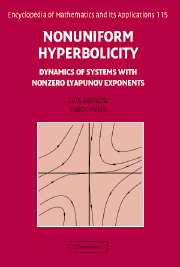Book contents
- Frontmatter
- Contents
- Preface
- Introduction
- Part I Linear Theory
- Part II Examples and Foundations of the Nonlinear Theory
- 6 Examples of Systems with Hyperbolic Behavior
- 7 Stable Manifold Theory
- 8 Basic Proper ties of Stable and Unstable Manifolds
- Part III Ergodic Theory of Smooth and SRB Measures
- Part IV General Hyperbolic Measures
- Bibliography
- Index
6 - Examples of Systems with Hyperbolic Behavior
from Part II - Examples and Foundations of the Nonlinear Theory
Published online by Cambridge University Press: 05 May 2013
- Frontmatter
- Contents
- Preface
- Introduction
- Part I Linear Theory
- Part II Examples and Foundations of the Nonlinear Theory
- 6 Examples of Systems with Hyperbolic Behavior
- 7 Stable Manifold Theory
- 8 Basic Proper ties of Stable and Unstable Manifolds
- Part III Ergodic Theory of Smooth and SRB Measures
- Part IV General Hyperbolic Measures
- Bibliography
- Index
Summary
In this chapter we describe some major examples of nonuniformly hyperbolic diffeomorphisms and flows. There are two principally different situations: (1) nonuniformly hyperbolic horseshoes and (2) systems preserving the Riemannian volume. In the first case, we show how to modify the classical horseshoe map to obtain a diffeomorphism possessing a compact invariant set ∧ (of zero volume) such that “almost any” invariant measure on ∧ is hyperbolic. In the second case we construct diffeomorphisms on surfaces and flows on three-dimensional manifolds with nonzero Lyapunov exponents with respect to the Riemannian volume.
We stress that in all cases the construction begins with a uniformly hyperbolic system (a horseshoe map, an Anosov diffeomorphism, or an Anosov flow) and goes on to slow down the trajectories of the system near a hyperbolic fixed point or a periodic trajectory. This destroys hyperbolicity and creates orbits with zero Lyapunov exponents. However, for the “majority” of orbits the Lyapunov exponents are nonzero.
Let us point out that absence of zero Lyapunov exponents imposes no obstructions on the topology of the manifold and, as we shall see in Sections 11.4 and 11.5, volume preserving diffeomorphisms and flows with nonzero Lyapunov exponents exist on any manifold (of dimension ≥2 in the case of diffeomorphisms and of dimension ≥3 in the case of flows).
Information
- Type
- Chapter
- Information
- Nonuniform HyperbolicityDynamics of Systems with Nonzero Lyapunov Exponents, pp. 139 - 187Publisher: Cambridge University PressPrint publication year: 2007
